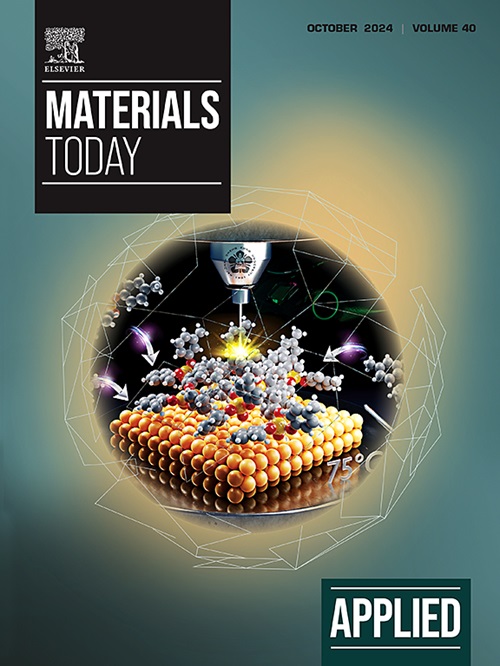ZnFe2O4 substituted with Cu atoms for ultra-efficient formation of sulfate radicals: Extremely low catalyst dosage for thiamethoxam degradation
IF 6.9
2区 材料科学
Q1 MATERIALS SCIENCE, MULTIDISCIPLINARY
引用次数: 0
Abstract
Neonicotinoids as one of the newest major class of insecticides is a kind of persistent pollutants. Herein, copper-substituted zinc ferrites (CuZnFeO) prepared in subcritical aqueous solution has a nanosize of ∼2 nm with high crystallinity and strong magnetic property. At low catalyst dosage of 0.05 g L, peroxymonosulfate (PMS) can be effectively converted into sulfate radicals in CuZnFeO/PMS system. Thiamethoxam (THIA) degradation rate is in the order of CuZnFeO > CuFeO > ZnFeO (124, 84, 21 × 10 min, respectively). At pH ∼7.0, THIA degradation efficiency can be over 99 % in 40 min. The radical species (, HO, SO and O) were demonstrated by EPR spectra using probe molecules. The majority effects in CuZnFeO/PMS system with kinetics modelling were comprehensively investigated as well. This work provides that multi-metal coupling, , Cu(Ⅰ)/Cu(Ⅱ) & Fe(Ⅱ)/Fe(Ⅲ), in spinel structure by polyhedral design is an effective strategy for enhancing the catalytic activity. The CuZnFeO/PMS system has promising for water treatment of neonicotinoid insecticide with ease of recycling catalysts by magnetic separation.用铜原子取代 ZnFe2O4,可超高效率地形成硫酸根自由基:噻虫嗪降解催化剂用量极低
新烟碱类杀虫剂作为最新的主要杀虫剂之一,是一种持久性污染物。在亚临界水溶液中制备的铜代锌铁氧体(CuZnFeO)具有 2 nm 的纳米尺寸、高结晶性和强磁性。在 0.05 g L 的低催化剂用量下,CuZnFeO/PMS 体系能有效地将过硫酸盐(PMS)转化为硫酸根。噻虫嗪(THIA)的降解速率依次为 CuZnFeO > CuFeO > ZnFeO(分别为 124、84、21 × 10 min)。在 pH ∼ 7.0 的条件下,40 分钟内 THIA 的降解效率可达 99% 以上。利用探针分子的 EPR 光谱证明了自由基物种(HO、SO 和 O)。此外,还利用动力学模型全面研究了 CuZnFeO/PMS 系统中的多数效应。这项研究表明,通过多面体设计在尖晶石结构中实现 Cu(Ⅰ)/Cu(Ⅱ) & Fe(Ⅱ)/Fe(Ⅲ) 多金属耦合是提高催化活性的有效策略。CuZnFeO/PMS 系统有望用于新烟碱类杀虫剂的水处理,并易于通过磁分离回收催化剂。
本文章由计算机程序翻译,如有差异,请以英文原文为准。
求助全文
约1分钟内获得全文
求助全文
来源期刊

Applied Materials Today
Materials Science-General Materials Science
CiteScore
14.90
自引率
3.60%
发文量
393
审稿时长
26 days
期刊介绍:
Journal Name: Applied Materials Today
Focus:
Multi-disciplinary, rapid-publication journal
Focused on cutting-edge applications of novel materials
Overview:
New materials discoveries have led to exciting fundamental breakthroughs.
Materials research is now moving towards the translation of these scientific properties and principles.
文献相关原料
公司名称
产品信息
麦克林
Ammonia
阿拉丁
p-Hydroxybenzoic acid
阿拉丁
p-Benzoquinone
阿拉丁
Furfuryl alcohol
阿拉丁
Tert‐butanol
阿拉丁
Absolute ethanol
阿拉丁
Peroxymonosulfate
阿拉丁
Thiamethoxam
阿拉丁
Citric acid
阿拉丁
Iron nitrate nonahydrate
阿拉丁
Zinc nitrate hexahydrate
阿拉丁
Copper nitrate trihydrate
 求助内容:
求助内容: 应助结果提醒方式:
应助结果提醒方式:


